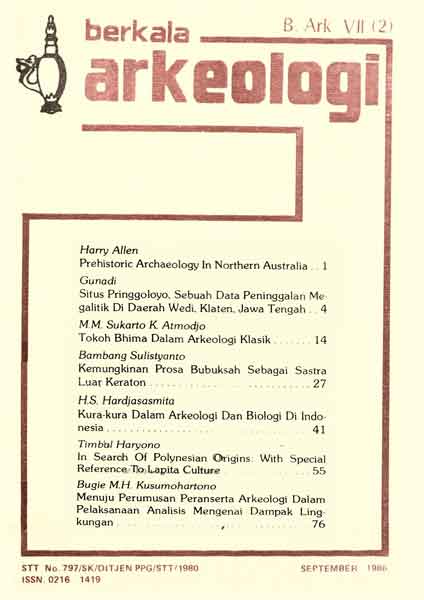IN SEARCH OF POLYNESIAN ORIGINS: WITH SPECIAL REFERENCE TO LAPITA CULTURE
Main Article Content
Abstract
The islands of Polynesia make up the largest group among the islands in the Pacific ocean. This group, in fact, consist of many islands forming a triangle. The main groups in the west are the Tongan, and Samoan and Ellice groups. The Cook, Society and Tuamotus lie in the east, with Easter Island as a far-off isolate, while the Hawaiian Islands and New Zealand are separated to the north and south respectively of the main west-east belt. The location of these islands between Asia in the west, Australia in the south and South America continent in the east is of considerable significance to the peopling and cultural development of the region. Many scholars have therefore been led to postulate the route of human movement into these scattered islands. Archaeological and anthropological researches have been carried out within the area to determine where the Polynesians originally come from. Various hypotheses have been proposed thereafter.
Article Details

This work is licensed under a Creative Commons Attribution-NonCommercial-ShareAlike 4.0 International License.
References
Bellwood, Peter. 1978. Polynesians, Prehistory of an island people London: Thomas and Hudson.
Benedict, Paul K 1942. Thai, Kadai and Indonesian. A new alignment in Southeastern Asia. American Anthropologist 44: 576 - 601.
Clark, Grahame. 1977. World Prehistory in New Perspective. 3rd edition, London, New York: Cambridge University Press.
Dixon, Roland B. 1920. A new theory of Polynesian origins. Proceeding of the American Philosophical Society vol. LIX: 261 - 267.
Dixon, Roland B. 1928. The Building of Cultures. New York, London: Charles Schribner's Sons.
Ferdon, Edwin N. 1963 Polynesian origin. Science 141: 499 - 505.
Gifford, E.W. 1951. Archaeological excavations in Fiji. Anthropological Records vol. 13 No. 3 : 189 - 288.
Gifford, E.W. and Shutler, Jr., Dick. 1956. Archaeological Excavations in New Caledonia. Anthropological Records vol. 18 No. 1 University of California Press.
Golson, J. 1961. Report on New Zealand, Western Polynesia, New Caledonia, and Fiji. Asian Perspectives V: 166 - 180.
Grace, George W. 1964. The Linguistic Evidence. Current Anthropology vol. 5 No. 5: 361 - 368.
Grace, George W. 1970. Austronesian Linguistic and Culture History. In Thomas, G. and Wallace, B.J. (eds.) Cultures of the Pacific. New York: The Free Press, London : Cllier-MacMillan Ltd. pp. 20 - 28.
Graydon, J.J. 1952. Blood Groups and the Polynesian. Mankind IV (8): 329 - 339.
Green, Roger. 1966. Linguistic sub-grouping with within Polynesia: The implication for prehistoric settlement. Journal of the Polynesian Society LXXV: 6 - 38.
Green, Roger. 1973. Lapita Pottery and the Origins of Polynesian Culture. Australian National History vol. 17 (10): 332 - 337.
Groube, L.M. 1971. Tonga, Lapita Pottery, and Polynesian Origins. Journal of the Polynesian Society vol. 80 (3): 278 - 316.
Hedrick, John D. 1971. Lapita Style Pottery from Malo Island. Journal of the Polynesian Society vol. 80 (1): 5 - 19.
Heyerdahl, Thor. 1950a. The Kon-Tiki Expedition. London: Allen and Unwin
Heyerdahl, Thor. 1950b. The Voyage of the Rift Kon-Tiki. An Argument for American Polynesian Diffusion. Geographical Journal vol. 115: 1 - 3.
Heyerdahl, Thor. 1952. American Indians in the Pacific. London: Allen and Unwin
Heyerdahl, Thor. 1961. Sea Routes to Polynesia. Expedition 4 (1): 22 - 29.
Heyerdahl, Thor. 1968 Sea Routes to Polynesia. New York: Rand McNelly & Co.
Li, Hui-Lin. 1970. The Origin of Cultivated Plants in Southeast Asia. Economic Botany 24: 3 - 19.
Oliver, D.I. 1961. The Pacific Islands. Rev. ed. New York.
Palmer, J.B. 1966. Lapita Style Potsherds from Fiji. Journal of the Polynesian Society 75 (3): 373 - 377.
Poulsen, J. 1964. Preliminary Report on Pottery Finds in Tonga. Asian Perspectives VIII: 184 - 195.
Sauer, Carl O. 1952. Agricultural Origins and Dispersal. New York: The American Geographical Society.
Sharp, Andrew. 1956. Ancient voyagers in the Pacific. Wellington: Polynesian Society.
Sharp, Andrew. 1956. 1963. Ancient voyagers in Polynesia. Auckland : Paul's.
Shuttler Jr., Richard and Marek, Jeffrey C. 1975. On the dispersal of the Austronesian horticulturalists. Archaeology & Physical Anthropology in Oceania vol. X (2): 81 - 113.
Simmons, R.T. 1961. Blood Groups genes in Polynesians and comparisons with other Pacific peoples. Oceania XXXII (1): 198 - 210.
Simmons, R.T., Graydon, J.J., Semple, N.M., and Fry, E.I. 1955. A blood group genetical survey in Cook Islanders, Polynesia, and comparisons with American Indians. American Journal Physical Anthropology 13: 667 - 690.
Simmons, RT. and Graydon, J.J. 1957. A blood group genetical survey in Eastern and Central Polynesians. American Journal Physical Anthropology 15 (3): 357 - 366.
Solheim II, W.G. 1959. Introduction to Sa-huynh. Asian Perspectives III: 97 - 108.
Solheim II, W.G. 1959. Sa-huynh Related Pottery in Southeast Asia Asian Perspectives III : 177 - 188.
Solheim II, W.G. 1962. Eastern Asia and Oceania. Asian Perspectives V (1): 5 - 1 5.
Solheim II, W.G. 1964a. Pottery and the Malayo-Polynesians. Current Anthropology vol. 5 No. 5 : 360 - 406.
Solheim II, W.G. 1964b. Further Relationships of the Sa-huynh - Kalanay Pottery Tradition. Asian Perspectives VIII : 196 - 211.
Specht, J. 1968 Preliminary Report of Excavations on Watom Island. Journal of the Polynesian Society 77 (2): 117 - 134.
Suggs, Robert C. 1970. The Kon-Tiki Myth. In Harding T.G and Wallace, B.J. (eds.) Cultures of the Pacifics. New York: The Free Press London: Collier-MacMillan, Ltd. pp. 29 - 38.
Swindler. Daris R. 1968. Problem of Melanesian Racial History.
Wurm, S.A. 1967. Linguistics and the Prehistory of the South-western Pacific. Journal of the Pacific History vol. 2: 25 - 38 .

